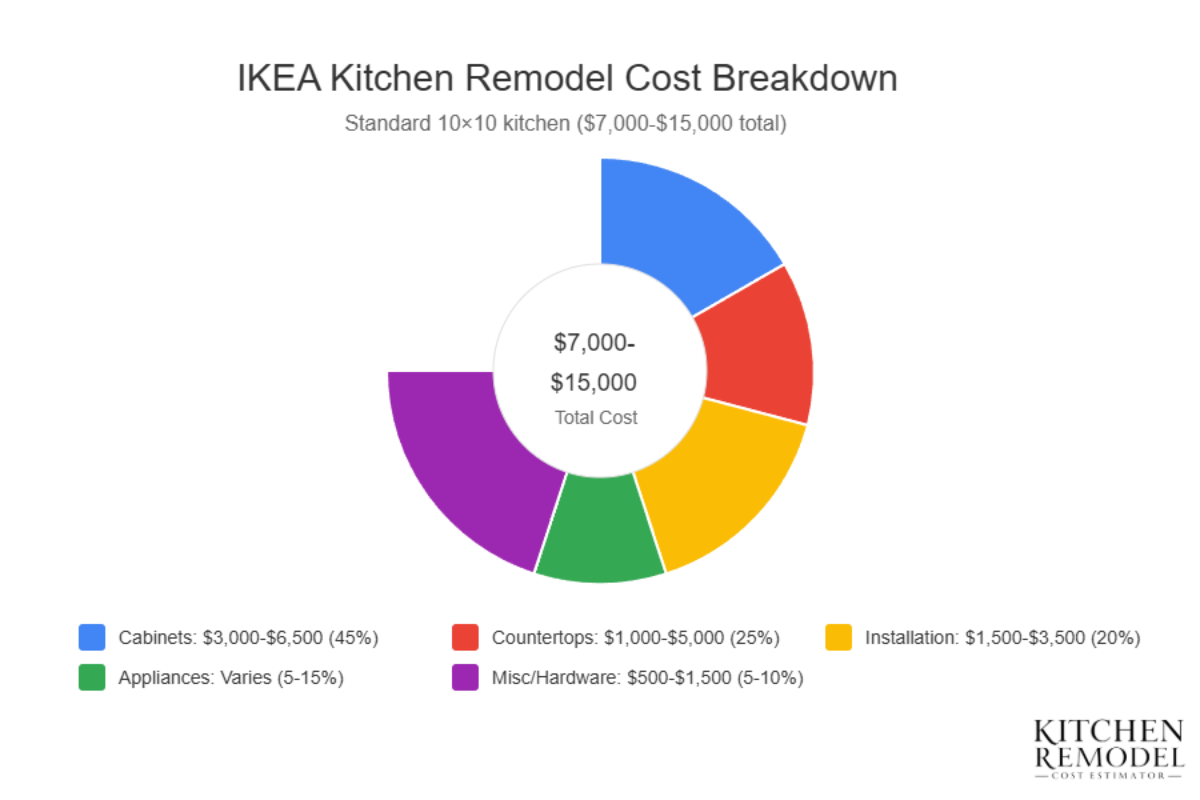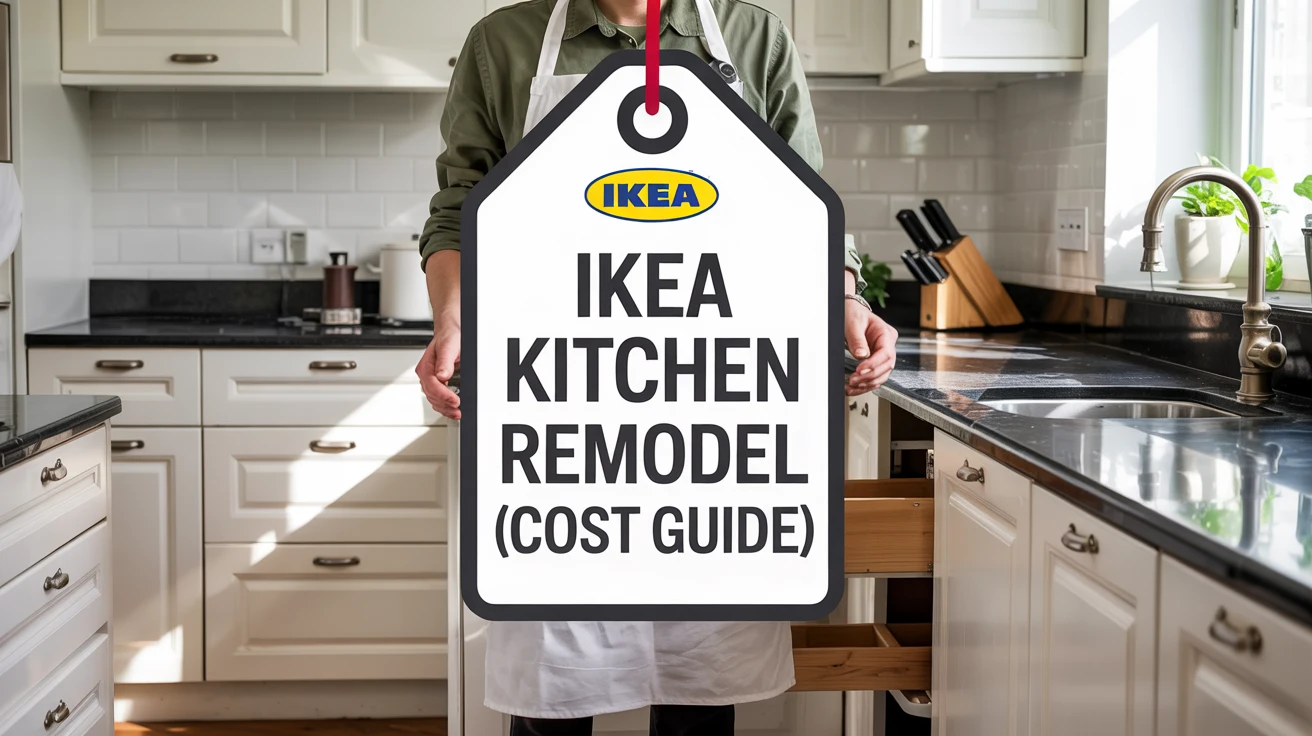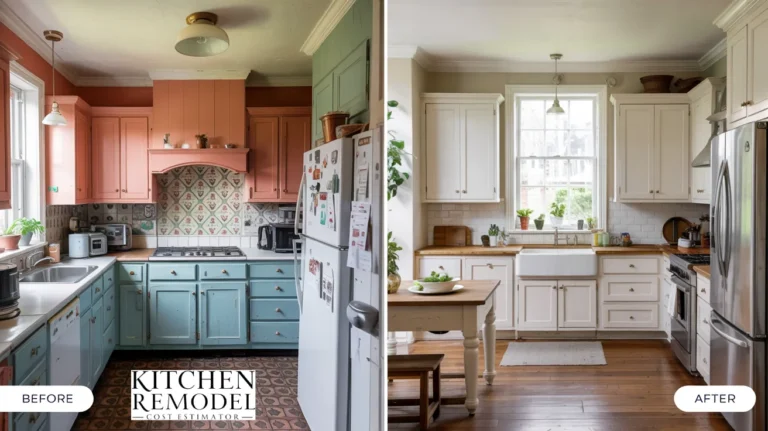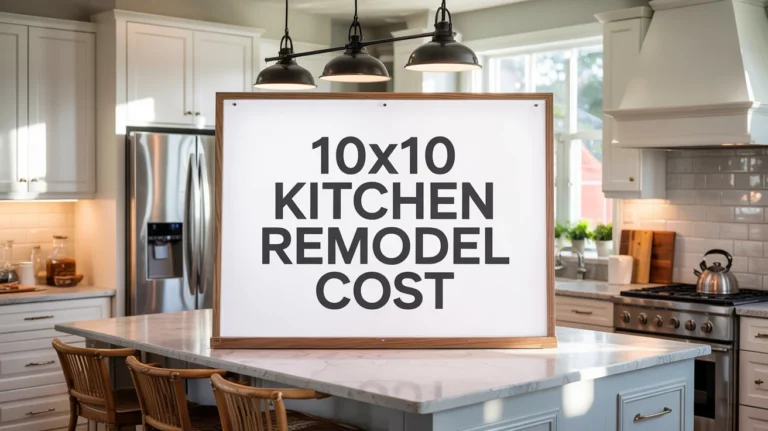Planning an IKEA kitchen renovation requires navigating a complex ecosystem of cabinets, countertops, and installation variables that can dramatically shift your bottom line.
How Much Does an IKEA Kitchen Remodel Cost?
An IKEA kitchen remodel typically ranges from $10,000 to $25,000, which includes cabinets, hardware, countertops, and installation. Costs vary depending on the kitchen’s size, material choices, and customizations. IKEA cabinets alone usually cost between $3,000 and $6,000 for a small kitchen, with installation and additional upgrades contributing to the overall price.
While IKEA’s ready-to-assemble format creates significant savings over traditional kitchen suppliers, your actual costs will vary based on material selections—particularly those cabinet door styles, which can double your cabinet budget from basic laminate to premium oak veneer options.
Typical Costs Associated with IKEA Kitchen Remodels in the United States
Average Total Cost
What should you actually budget for your IKEA kitchen transformation? The financial landscape spans quite a range, typically falling between $7,000 and $15,000 for a complete project.

Why such a wide spread? Your actual cost depends on several variables unique to your situation—kitchen size, cabinet and countertop materials, and installation complexity all play crucial roles in your final investment.
Some analyses suggest potentially higher figures might be more realistic. One report indicated that a modest 120 square foot IKEA kitchen remodel could range from $30,000 to $50,000 when accounting for both materials and labor. This higher estimate likely reflects regional variations in labor costs or perhaps a more comprehensive definition of what constitutes “complete”—possibly including high-end appliances or significant structural modifications.
At the more accessible end of the spectrum, basic IKEA kitchen renovations have been reported to start as low as $8,000.
For those undertaking larger or more upscale IKEA projects, the investment can climb to between $15,000 and over $50,000. At this higher tier, IKEA renovations begin approaching price points typically associated with traditional kitchen remodels, which frequently start around $20,000 and can easily exceed $50,000 depending on scope.
A specific cost comparison from New York City illustrates this point perfectly. There, IKEA kitchen renovations were estimated at $10,000 to $15,000—significantly less than the $30,000 to $35,000 quoted for comparable kitchens from a major big-box retailer. This suggests IKEA can offer a particularly cost-effective solution in urban environments where renovation expenses tend to run higher.
The considerable variability in these figures underscores something important: you need a detailed, personalized cost assessment for your specific kitchen remodel.
What does this wide range tell us? First, that kitchen renovations are highly adaptable—from basic updates to extensive overhauls. Second, that a single average figure can’t accurately represent the diverse projects homeowners undertake. And third, that IKEA’s consistently lower costs point to fundamental differences in their business model compared to conventional retailers.
This advantage likely stems from IKEA’s ready-to-assemble format, strategic material selections, and streamlined supply chain. The higher cost projection from one source, while an outlier, reminds us to consider the methodology behind any estimate—particularly regarding labor inclusion and geographical location.
Typical Cost per Square Foot
How much will your IKEA kitchen cost per square foot? According to one report, you can expect to spend between $70 and $150 per square foot for a complete renovation. This figure includes both material expenses and installation labor costs.
Why does this metric matter? It provides you with a more practical benchmark for estimating your kitchen remodel’s financial impact, especially during those initial planning stages when you’re still considering the overall scale of your project.
By knowing your kitchen’s approximate square footage, you can quickly calculate a preliminary budget estimate before diving into the specifics of cabinet styles, countertop materials, and installation complexities.
The range of $70 to $150 per square foot suggests that, similar to total project costs, the price per unit area fluctuates significantly based on your choices. Opt for premium countertop materials like quartz or select high-end cabinet door styles? You’ll likely land toward the higher end of that spectrum.
Is your renovation going to involve significant modifications to the kitchen layout, requiring more extensive labor? That would also push you toward the upper end of the per-square-foot range.
This metric serves as a valuable tool for your initial budget forecasting, helping you align your renovation dreams with financial reality.
The variability in cost—from a more budget-friendly $70 to a potentially more premium $150 per square foot—directly reflects the different tiers of materials and customization levels available in IKEA kitchen designs.
Working with tighter budget constraints? You might lean toward laminate countertops and basic cabinet fronts, resulting in a lower per-square-foot investment.
Seeking a more luxurious finish with features like solid wood veneer cabinets and quartz countertops? Expect to invest more per square foot.
This measurement effectively bridges the gap between your project’s overall scale and the detailed costs of individual components, offering a practical way to navigate the financial landscape of your IKEA kitchen remodel.
IKEA Kitchen Cabinet Costs and Durability by Material Type
How much of your budget will go toward cabinets? For many homeowners, this represents the largest chunk of their IKEA kitchen investment.
graph TD
title[IKEA Cabinet Styles Cost Comparison]
A[IKEA Cabinets for<br>10x10 Kitchen] --> B[Economy<br>$2,000-$2,500]
A --> C[Mid-range<br>$2,600-$3,500]
A --> D[Premium<br>$3,600-$4,500]
B --> B1[ASKERSUND<br>$2,078<br>Laminate]
B --> B2[VEDDINGE<br>$2,069<br>Painted]
B --> B3[HAVSTORP<br>$2,069<br>Painted]
C --> C1[BODARP<br>$2,554<br>Laminate]
C --> C2[AXSTAD<br>$3,017-$3,022<br>Painted/Thermofoil]
C --> C3[BODBYN<br>$3,195-$3,215<br>Painted MDF]
D --> D1[SINARP<br>$3,403<br>Wood Veneer]
D --> D2[RINGHULT<br>$3,622<br>High-Gloss]
D --> D3[VEDHAMN<br>$4,319<br>Oak Veneer]
classDef default fill:#f9f9f9,stroke:#333,stroke-width:1px;
classDef title fill:#ffffff,stroke:none,color:#333,font-size:16px;
classDef category fill:#0075c2,stroke:#333,color:white,stroke-width:1px;
classDef economy fill:#5aaa4e,stroke:#333,color:white,stroke-width:1px;
classDef midrange fill:#f5e160,stroke:#333,color:#333,stroke-width:1px;
classDef premium fill:#ea596e,stroke:#333,color:white,stroke-width:1px;
class title title;
class A category;
class B,C,D category;
class B1,B2,B3 economy;
class C1,C2,C3 midrange;
class D1,D2,D3 premium;
For a standard 10×10 kitchen layout, expect to spend between $3,000 and $6,500 on IKEA cabinets. This total typically breaks down into cabinet materials ($2,000-$4,000) and professional installation ($1,000-$2,500).
Looking at it another way, the installed cost of IKEA kitchen cabinets generally runs $150 to $300 per linear foot.
Individual cabinet prices vary considerably by type and size. Base cabinets typically cost between $80 and $300 each, while wall cabinets range from $50 to $200 each. Need taller pantry-style cabinets? Budget between $600 and $1,200 apiece.
What really drives cabinet cost variation? Your choice of door and drawer front style has a major impact, with material type being the crucial factor.
For a standard 10’x10′ kitchen, the difference in material costs alone tells the story. Styles like ASKERSUND, with their laminate finish, come in around $2,078. Options such as AXSTAD and BODBYN, featuring painted or thermofoil finishes on MDF, jump to approximately $3,017-$3,215. Want the warmth of wood? Cabinets with oak veneer, like VEDHAMN, can cost upwards of $4,319 in materials alone.
What are these cabinets actually made of? IKEA cabinet boxes primarily use a 3/4″ particleboard core, covered with melamine foil and plastic edging. The door and drawer fronts utilize medium-density fiberboard (MDF) with various finishes—including real wood veneers, thermofoil, paint, metal, or glass.
How long will they last? IKEA cabinets constructed with engineered wood reportedly have a potential lifespan of 25 to 30 years. Many users share positive experiences, noting their IKEA kitchens have remained in good condition for over a decade.
Some reports do indicate potential issues with surface finishes—veneer peeling or chipping on doors after extended use. However, IKEA backs their SEKTION kitchen system with a 25-year limited warranty covering defects in materials and workmanship.
Does IKEA’s reliance on particleboard and MDF for cabinet construction compromise durability? The reported lifespan and 25-year warranty suggest these materials, when engineered and assembled to IKEA’s standards, offer substantial durability for typical kitchen use.
This challenges a common misconception that solid wood is the only marker of quality cabinetry. The significant price differences between door and drawer front styles clearly demonstrate how aesthetic preferences and finish materials directly impact your overall cabinet costs.
The occasional reports of finish-related issues, while not widespread, do highlight a potential vulnerability—areas where wear might become noticeable over longer periods, particularly in busy households.
| Front Style | Material Costs (USD) | Likely Material |
|---|---|---|
| ASKERSUND | $2,078 | Laminate |
| AXSTAD | $3,017 – $3,022 | Painted or Thermofoil on MDF |
| BODARP | $2,554 | Laminate |
| BODBYN | $3,195 – $3,215 | Painted on MDF |
| ENKÖPING | $2,247 | Veneer or Laminate on MDF |
| HAVSTORP | $2,069 | Painted |
| KUNGSBACKA | $2,398 | Foil Finish |
| LERHYTTAN | $3,799 | Stained Wood or Veneer on MDF |
| NICKEBO | $2,602 | Foil Finish |
| RINGHULT | $3,622 | High-Gloss Laminate or Lacquer on MDF |
| SINARP | $3,403 | Wood Veneer on MDF |
| STENSUND | $2,647 | Painted |
| UPPLÖV | $3,959 | Foil Finish |
| VEDDINGE | $2,069 | Painted |
| VEDHAMN | $4,319 | Oak Veneer on MDF |
| VOXTORP | $3,998 | Veneer or Laminate on MDF |
Countertop Costs and Durability Compatible with IKEA Kitchens
How do you choose the right countertop for your IKEA kitchen? Each material offers its own unique balance of cost, aesthetics, and durability.
Laminate countertops represent the budget-conscious option, with installation costs ranging from $1,000 to $2,500 or $39 to $109 per square foot (including IKEA’s installation and fabrication services). Individual 74-inch laminate slabs are priced between $79 and $99, with IKEA’s EKBACKEN series known for its appealing aesthetics and value.
What makes laminate appealing beyond price? It offers a wide array of styles and remains relatively easy to maintain. The downsides? Heat resistance is limited, lifespan is generally shorter compared to stone materials, and scratches can be an issue.
Looking for something more premium? Quartz countertops typically cost between $2,500 and $5,000 for installation. Material costs alone range from $59 to $89 per square foot, with installed costs estimated at $64 to $69 per square foot. IKEA’s custom KASKER quartz runs around $95 per square foot, while non-IKEA quartz options may start from $50 to $65 or more per square foot.
Why the higher price for quartz? It earns its premium with exceptional durability, minimal maintenance requirements, scratch resistance, and a non-porous surface that resists staining.
Want something in the middle range? Solid surface countertops offer a mid-tier option, priced between $30 and $75 per square foot.
Granite countertops, celebrated for their durability, cost about $40 to $60 per square foot for the material, with total installed costs potentially ranging from $2,000 to $4,500.
Prefer a warmer, natural look? Butcher block or wood veneer countertops from IKEA range from $109 to $349 per pre-cut slab, with the KARLBY series priced at $249 for a 74-inch piece. These offer a natural aesthetic and can be refinished if needed—though wood requires regular resealing to prevent water damage.
How do we objectively evaluate countertop performance? Several ASTM standards provide benchmarks. For laminate, ANSI/AWI 1236-2022 outlines structural requirements, including load resistance. Technical data from manufacturers like Formica and Wilsonart reference standards such as ANSI/NEMA LD3, ASTM E-84 for fire rating, and NSF Standard 35 for food contact safety.
Quartz manufacturers frequently cite a range of ASTM standards for physical properties and performance—including compressive strength (ASTM C-170), water absorption (ASTM C-97), flexural strength (ASTM C-880), abrasion resistance (ASTM C241), and stain resistance (ANSI Z 124.6).
For wood countertops, ANSI/AWI 1236-2022 references ASTM D1037 for substrate swell factor, and a VA specification mentions ANSI/AHA A135.4 for hardboard options. While general ASTM standards for wood properties exist, a specific standard for finished wood kitchen countertops wasn’t prominently identified in the research.
What do these diverse cost ranges tell us? They underscore the significant financial implications of your material selection. Laminate provides the most economical entry point, while quartz and granite demand a greater investment for enhanced durability and aesthetic appeal.
The presence of numerous ASTM standards for laminate and quartz offers you a degree of objective assessment when evaluating product specifications. The relative absence of specific standards for finished wood kitchen countertops suggests their quality and longevity depend more on wood species, finish quality, and ongoing maintenance.
| Material | Cost per Square Foot (USD) | Typical Installation Cost (USD) | Key Durability Notes | Relevant ASTM Standards |
|---|---|---|---|---|
| Laminate | $39 – $109 | $1,000 – $2,500+ | Decent, resists stains/scratches (some), limited heat resistance, shorter lifespan | ANSI/AWI 1236, ANSI/NEMA LD3, ASTM E-84, NSF Standard 35 |
| Quartz | $50 – $95+ | $2,500 – $5,000+ | Very durable, low maintenance, scratch-proof, non-porous | ASTM C-170, ASTM C-97, ASTM C-880, ASTM C241, ASTM C1028, ASTM D-790, ASTM D-256, ASTM C-1026, ANSI Z 124.6, ASTM E-84 |
| Solid Surface | $30 – $75 | Not specified | More affordable than quartz | Not specified |
| Granite | $40 – $60 | $2,000 – $4,500 (installed) | Durable | Not specified |
| Butcher Block/Wood Veneer | $109 – $349 (per slab) | Not specified | Natural look, can be sanded/treated, requires regular resealing, prone to water damage | ANSI/AWI 1236 (mentions ASTM D1037 for substrate), ANSI/AHA A135.4 (for hardboard options), General ASTM standards for wood properties (D series) |
Professional Installation Costs
How much should you budget for professional installation? This often-overlooked expense represents a significant portion of your IKEA kitchen remodel cost.
Estimates for professional installation of a complete IKEA kitchen range from $1,500 to $3,000. Other sources suggest average labor expenditures between $2,500 and $3,500 for a typical remodel.
Looking specifically at cabinet installation? Costs vary from $1,000 to $2,500 for a standard 10′ x 10′ kitchen, or $50 to $120 per linear foot. Some installers price their services per cabinet—around $120-$150 for non-IKEA recommended professionals and approximately $250 for installers recommended by IKEA.
Don’t forget about countertop installation, which typically adds $20 to $40 per square foot to your budget.
What about appliances? Their installation can contribute substantially to your labor expenses, ranging from $550 to $2,500 per individual appliance. Installing a full suite of kitchen appliances could run between $3,200 and $9,000.
Need specialized work like electrical modifications? Licensed electricians typically charge around $90 per hour.
One helpful guideline suggests that professional installation costs often amount to approximately 50% of your total IKEA kitchen materials expense.
Why such significant variation in installation costs? Multiple factors come into play—your kitchen design complexity, space size, and regional labor rates all influence what you’ll pay.
While IKEA kitchens are designed with easier installation in mind, standard installation services typically cover only assembly and mounting of cabinets. They often don’t include specialized trades like plumbing and electrical work.
These tasks frequently require licensed professionals and generate additional costs, particularly if your renovation plan involves relocating fixtures or adding new electrical circuits.
What’s the takeaway? Obtain detailed, itemized quotes from multiple installers to understand exactly what services are included and to effectively compare pricing.
Return on Investment (ROI)
Will your IKEA kitchen remodel pay for itself when you sell your home? Kitchen renovations generally rank among the home improvement projects with substantial return on investment.
Typical ROI figures for kitchen renovations range from 60% to 80%, with potential to exceed 100% in certain circumstances. Other analyses report ROI ranges from 31.7% to 85.7% and 50% to over 70%.
Here’s an interesting insight: minor kitchen remodels often yield a higher percentage return compared to more extensive renovations.
What about IKEA kitchen remodels specifically? Their cost-effectiveness can lead to significant return on investment by enhancing your home’s overall appeal. Minor IKEA kitchen renovations typically recoup around 70% of the initial investment, while midrange projects yield approximately 60% ROI.
What factors influence your kitchen remodel’s ROI? Several elements come into play—material quality and durability, layout functionality and design, aesthetic appeal of the finished space, and your local real estate market conditions.
It’s worth noting that outdated kitchen styles can negatively impact your potential return. A common guideline for maximizing ROI: invest between 5% and 15% of your home’s current market value in the project.
What does all this tell us? The positive ROI associated with kitchen remodels indicates that investing in this area of your home is often financially prudent.
While specific ROI data for IKEA kitchens is somewhat limited, available information suggests their affordability contributes to a favorable return, potentially maximizing the percentage of your investment recouped upon resale.
This implies IKEA offers a value-driven approach to kitchen remodeling—beneficial not only for immediate enjoyment but also from a long-term financial perspective.
Remember that your actual ROI depends on various factors, including your specific material and design choices within the IKEA system, as well as broader dynamics in your local housing market.
Typical Lifespan and Durability
How long will your IKEA kitchen actually last? IKEA cabinet longevity depends primarily on their construction materials and usage patterns.
IKEA kitchen cabinets, primarily built from engineered wood such as MDF with laminate or veneer finishes, generally have an expected lifespan of 25 to 30 years. Numerous user accounts support this expectation, with many reporting their IKEA kitchens remaining in good condition for 10 to 14 years, sometimes longer.
Some users have noted issues with surface finishes over time—veneer peeling or chipping, particularly on frequently used doors and drawer fronts. IKEA backs their SEKTION kitchen system with a 25-year limited warranty, suggesting confidence in their product durability.
What about countertop longevity? This varies significantly by material choice. Laminate options typically have shorter lifespans compared to more robust materials like stone or quartz.
Quartz countertops have earned their reputation for exceptional durability and can be expected to last for many years with minimal maintenance.
Wood countertops, such as butcher block, can offer a lifespan around 20 years—but this depends heavily on proper and consistent maintenance, including regular resealing to prevent moisture damage.
Wondering about IKEA kitchen hardware durability—hinges, drawer slides, and other mechanical components? While not extensively covered in the research, IKEA’s 25-year warranty on the SEKTION system suggests an expectation of durability for these parts as well. User reviews frequently mention the reliable functionality of soft-closing hinges and drawers over several years of use.
Are there industry-wide standards for cabinet lifespan? While IKEA’s 25-year warranty provides a strong indication of expected longevity, specific industry standards for kitchen cabinet lifespan weren’t prominently featured in the research. For countertops, ASTM standards primarily address material performance characteristics rather than defining specific lifespans.
What’s the real-world takeaway here? The 25-year warranty offered by IKEA, combined with positive long-term user experiences, provides reasonable durability expectations for an IKEA kitchen’s core structure.
The occasional reports of issues with door and drawer surface finishes suggest these elements might have more variable longevity depending on household usage patterns and environmental conditions.
Your countertop lifespan will be largely determined by material choice, aligning with general expectations for these materials in any kitchen setting.
Comparative Cost
How does IKEA’s pricing stack up against other kitchen renovation options? IKEA kitchens are widely recognized as a more budget-friendly alternative to traditional, fully custom kitchen renovations.
A direct cost comparison in New York City puts this in stark perspective: an IKEA kitchen was estimated at $10,000 to $15,000, while a comparable kitchen from a major retailer like Home Depot (see Home Depot Kitchen remodel cost) would run significantly higher—around $30,000 to $35,000. That’s a potential savings of $20,000 or more.
Traditional kitchen remodels often start at approximately $20,000 as a baseline. Custom kitchen cabinets, which offer the highest degree of design flexibility and material choice, can be substantially more expensive than IKEA’s stock offerings. High-end custom installations potentially exceed $23,500 for even a relatively small kitchen.
How does IKEA compare to other ready-to-assemble (RTA) cabinet providers? For a 10×10 kitchen layout, IKEA costs range from $3,000 to $8,000, while other RTA options might be priced between $2,000 and $6,000. This suggests that while IKEA is generally affordable, it’s not always the absolute lowest-cost provider in the RTA category.
What about the middle ground? Semi-custom cabinets occupy that space in the market, offering a balance between the cost-effectiveness of stock options like IKEA and the full customization capabilities of bespoke cabinetry.
Why is IKEA consistently positioned as a more affordable alternative? This cost advantage likely stems from their efficient business model—prioritizing flat-pack assembly, standardized designs, and manufacturing economies of scale.
While IKEA offers significant savings compared to major retailers, exploring other RTA cabinet suppliers might reveal even more budget-friendly options if minimizing upfront costs is your primary concern.
The existence of semi-custom and custom alternatives at higher price points reflects the tradeoffs involved—between cost, personalization level, and potential for higher-grade materials.
Conclusion
What’s the bottom line on IKEA kitchen remodels?
Most complete projects fall between $7,000 and $15,000, or roughly $70 to $150 per square foot including materials and installation.
Your biggest expense? Cabinets, running $3,000 to $6,500 for a standard 10×10 kitchen, with variations based on door style and material.
Countertops range from budget-friendly laminate ($1,000+) to premium quartz ($2,500+), each offering distinct durability profiles.
Professional installation adds another $1,500 to $3,500 to your total. Don’t forget specialized work costs extra.
The good news? These investments typically return 60-70% of your money when you sell, with IKEA’s SEKTION system backed by a reassuring 25-year warranty.
Compared to traditional or custom options, IKEA delivers remarkable value—making high-quality kitchen renovations accessible to more homeowners without sacrificing longevity.
FAQ
How much does it cost to have someone install an IKEA kitchen?
Professional installation for an IKEA kitchen costs $2,500–$5,000, depending on the complexity and size of the project. This includes cabinet assembly and fitting but excludes countertops and appliances.
Can you do a kitchen for $5000?
A $5,000 kitchen remodel is possible with budget-friendly materials like IKEA cabinets and DIY labor. It typically covers basic cabinetry and countertops but excludes high-end appliances or extensive structural changes.
What is a reasonable budget for a kitchen remodel?
A reasonable budget for a kitchen remodel ranges from $10,000 to $50,000, depending on the scope. Mid-range projects average $25,000–$35,000, balancing quality materials and professional labor.
What price are IKEA kitchens?
IKEA kitchens cost $1,500–$15,000, varying by size and components. Small kitchens start at $1,500–$4,000, medium kitchens range from $4,000–$10,000, and large kitchens cost $10,000–$15,000.





